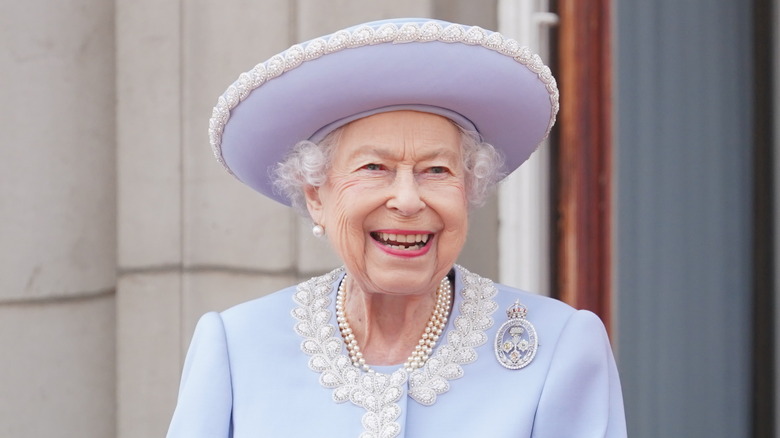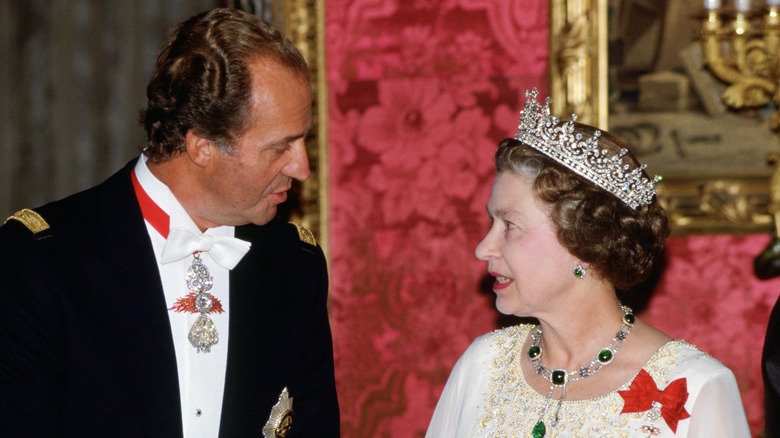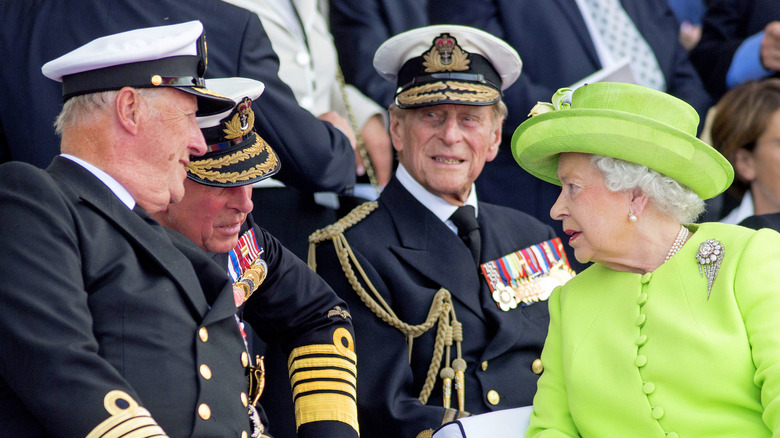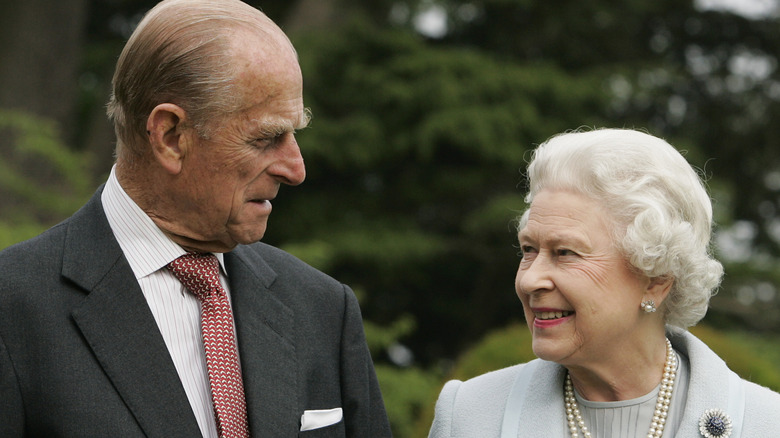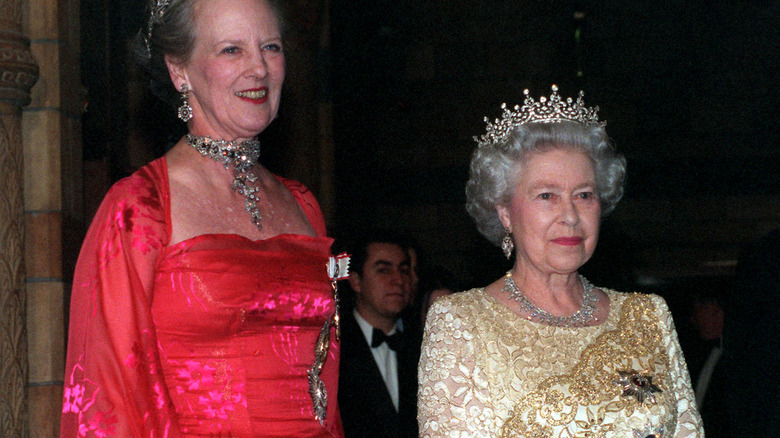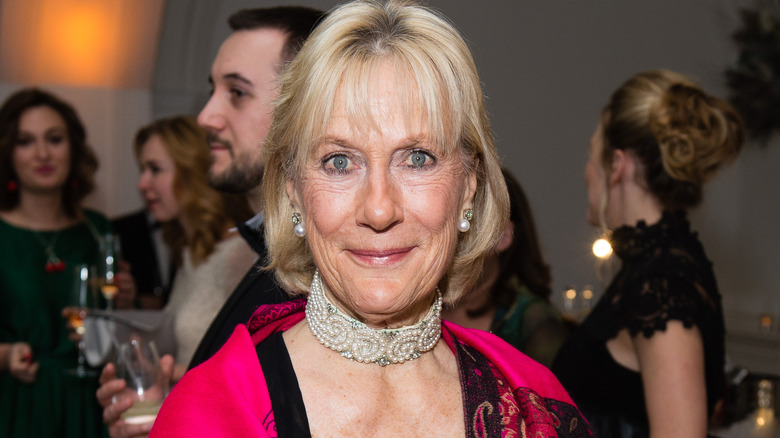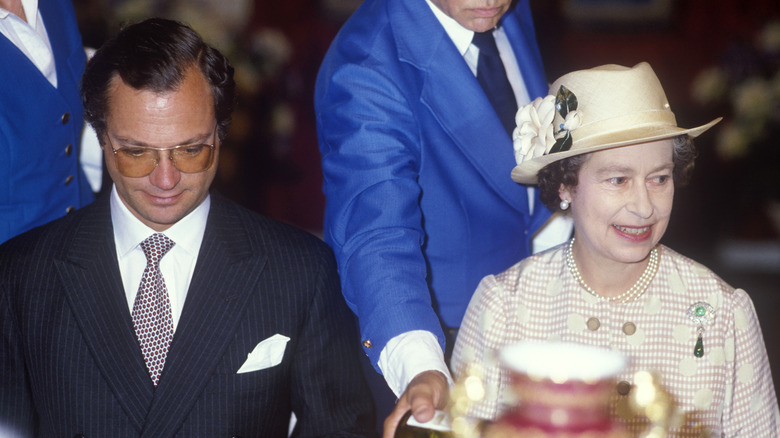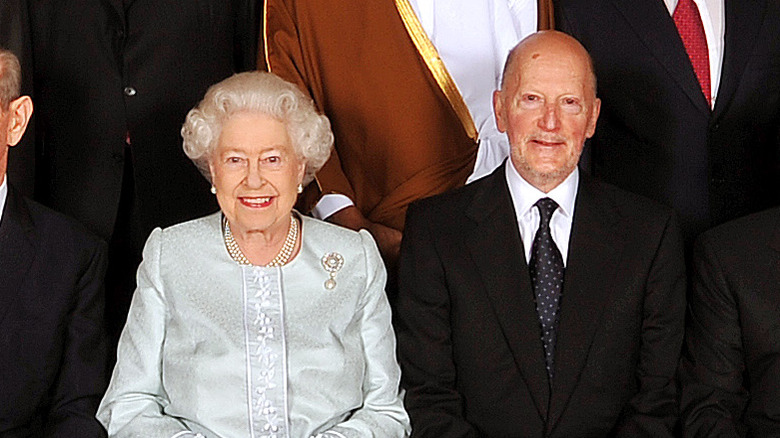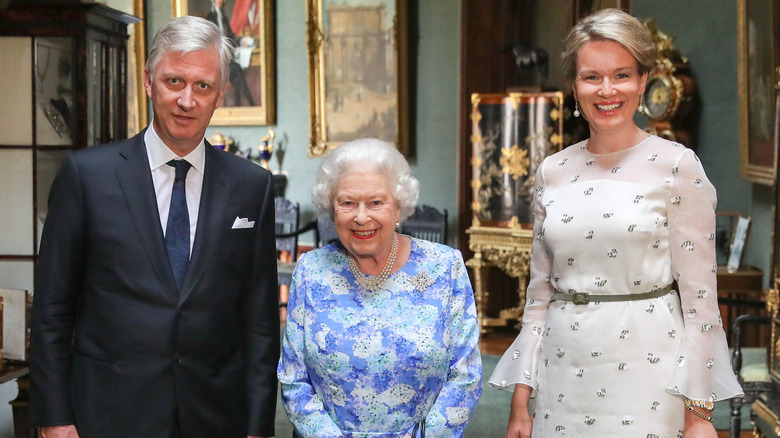8 Royal Families Who Are Surprisingly Related To Queen Elizabeth
Queen Elizabeth II was part of one of the biggest royal dynasties ever seen, reigning through troubling times and weathering unprecedented scandals in the public eye. Three out of four of her children got divorced in the '90s, with Sarah, Duchess of York, Princess Diana, and King Charles III all landing major headline spots for their extramarital activities. Many years later, Prince Harry and Meghan, Duchess of Sussex, would also be at the center of a worldwide media storm. Somehow, Elizabeth always maintained her classic stiff-upper-lip attitude throughout any turbulence, doing her best to represent an institution centuries old. After all, her lineage is important and needs to be treated as such.
The British monarchy extends far beyond just Elizabeth, with her great-great-grandmother, Queen Victoria, having nine children who started their own royal lineages across Europe. The royal family's influence spans the globe, with Elizabeth's relatives on thrones from Spain to Belgium and even defunct monarchies like Russia. Surprisingly, Elizabeth even married her relation, but this is rarely talked about as it is deemed a little too taboo by modern standards.
Elizabeth visited some of her relatives on occasion on state visits, taking the opportunity to see family while also paying respects as a royal. In fact, one of her cousins is currently the longest-reigning queen in Europe, a title she assumed when Elizabeth died in 2022. Let's take a look at just how wide-reaching Elizabeth's bloodline really is.
King Juan Carlos I of Spain
While it may not be talked about as much as the British royal family, Spain still has a monarchy. The father of King Felipe VI is King Juan Carlos I, who is the distant great-grandson of none other than Queen Victoria. His grandmother, Victoria Eugenia, was the granddaughter of Victoria's youngest daughter, Princess Beatrice. This makes Juan Carlos and Elizabeth third cousins — but the connection doesn't stop there. Juan Carlos' wife, Queen Sofia, is also Elizabeth's third cousin and Prince Philip's first cousin, which makes things all the more confusing.
Juan Carlos and Sofia visited Britain in 1986, with Elizabeth and Philip returning the favor by traveling to Spain two years later. Alas, as Time noted at the time, Juan Carlos' reign ended in a rather unflattering way in 2014 when he abdicated after almost four decades on the throne. At the time, his son-in-law was being investigated for corruption, and an ill-timed elephant hunting trip saw Juan Carlos' popularity plummet. If that wasn't enough, in 2020 he moved to the United Arab Emirates after prosecutors expressed an interest in talking to him over a business deal gone wrong with Saudi Arabia, per BBC News.
His son, Prince Felipe, became King Felipe VI of Spain after his father stepped down, and maintained ties with Elizabeth by visiting in 2017 alongside his wife, Queen Letizia. The couple was even treated to a lavish State Banquet as well as a Horse Guards Parade.
King Harald V of Norway
Norway's monarchy doesn't really make headlines around the globe, but the royal house actually dates back more than one thousand years, making it ancient and incredibly important to the country. The first sovereign, Herald Fairhair, was the first one to make a stand and bring the people together back around 885. As you can imagine, it's a pretty important lineage. Herald may not have been related to Queen Elizabeth II, but the current king, Harald V, is. The pair shared the same great-grandparents, King Edward VII and Queen Alexandra. Because of this fairly close tie, Harald is actually 77th in line for the British throne ... although it's improbable he'll ever get a sniff of the crown jewels.
Elizabeth spent some time with her Norwegian cousin and counterpart back in 2018 when she visited the Anglo-Norse Society in London. Harald accompanied her, making for a sweet family reunion as they greeted supporters and students at the society, which grants scholarships to British academics to study abroad in Norway. Interestingly, Elizabeth's first-ever overseas State Visit in 1955 was to Norway, where she was welcomed by the king at the time, King Hakoon.
Many years later in 1988, Elizabeth received King Olav, Harald's father, at Windsor Castle. Harald and his wife Queen Sonja didn't attend the coronation of King Charles III but sent their son, Crown Prince Haakon, in their place. Even though Elizabeth is gone, it's likely this familial friendship between states will continue for generations.
Prince Philip of Greece and Denmark (and Britain)
This particular connection is rarely spoken about, perhaps because it can seem a little off-putting to some. It's no secret that the British royals have been known to keep it in the family, so to speak. Queen Victoria and her beloved husband, Prince Albert, were very closely related as first cousins who were even delivered by the same midwife. While this close connection may seem bizarre now, it wasn't (and continues not to be) illegal in the United Kingdom. Of course, many royals opt to marry outside of the firm now ... but Queen Elizabeth II didn't have to look further than the family tree to find a husband.
Prince Philip was actually royalty before he ever married Elizabeth, as he was born into both the Greek and Danish royal bloodlines. He gave up his title of Prince Philip of Greece and Denmark to marry the sovereign, who was also his third cousin thanks to their shared great-great-grandmother, Queen Victoria. In fact, this wasn't their only familial tie as they were also second cousins once removed thanks to their tie to King Christian IX of Denmark. By all accounts, Philip and Elizabeth had a happy marriage, braving many storms and scandals together before he died aged 99 in 2021. Today, the pair are buried side by side at St. George's Chapel close to Windsor Castle, where they spent much of their time.
Queen Margrethe II of Denmark
There aren't very many monarchs out there that can be compared to Queen Elizabeth II. She reigned for over 70 years, becoming a cornerstone of the British landscape, an emblem as solid and dependable as a cup of tea, or Paddington Bear. If anyone can even come close to Elizabeth, it's her third cousin, Queen Margrethe II of Denmark. The pair shared a unique bond thanks to their longevity as female sovereigns, with Margrethe marking 50 years on the throne in 2022. When Elizabeth died, Margarethe became the longest-serving monarch in Europe, a title that she no doubt treasures. The third cousins also had a unique bond, both becoming queens after losing their fathers at a young age.
In fact, in an interview with ITV prior to Elizabeth's Platinum Jubilee in 2022, Margarethe expressed her adoration for her cousin. "[Elizabeth] was 26 when she became Queen. When I was growing up, I hoped I wouldn't be as young as that when my father died," she said. "It made an enormous impression on me. The fact that she was dedicating her life. I understood what that meant. This is for life. That is the whole point of my life. And I know she sees that too." Over the years, they were pictured at several events together, smiling in tandem. Margrethe was also the first foreign royal to send King Charles III and Camilla, Queen Consort, her well-wishes following the death of Elizabeth, calling her a "towering figure among the European monarchs" (via Daily Mail).
Princess Olga Romanoff
This one is particularly interesting as it ties Queen Elizabeth II to one of the biggest moments in history: the overthrowing of Russia's Imperial family. The House of Windsor is tied to the Romanovs as Elizabeth's grandfather, King George V, was the cousin of the ill-fated Tsar Nicholas II. The Romanovs were brutally culled in 1918 by Bolsheviks, who wiped out the entire household, including the tsar's children. Amazingly, some Romanovs managed to escape, including Nicholas' sister Grand Duchess Xenia Alexandrovna, and her husband who fled Russia a year after the murders took place. Their granddaughter, Princess Olga, is still alive and well and living as a British citizen ... but how is she related to Elizabeth?
Nicholas was the cousin of King George V, who was Elizabeth's grandfather, making them distant cousins. (As WWI buffs will be quick to point out, George and Nicholas were also cousins to Emperor William II of Germany.) Though Olga may not be strictly royal now, she always maintained a deep respect for the late queen, telling Channel 9 (via Sky News): "[She was] great fun, very charming and so normal, you know, she was just a really amusing person that likes a joke, but you always are aware that she was the queen." Olga went on to express her opinion that King Charles III will be a great leader for Britain, who will do an "amazing job." Olga was related to Prince Philip as well, through Greek royal family ties.
King Carl XVI Gustaf of Sweden
King Carl XVI Gustaf of Sweden and Queen Elizabeth II go way back as they are both distant grandchildren of Queen Victoria. Elizabeth's tie to Victoria extends through her father, King George VI, while Carl Gustaf is a descendant of two of Victoria's sons, Prince Arthur and Prince Leopold. Carl Gustaf first took the throne on September 15, 1973.
Alongside his wife, the king has visited Britain on several occasions, including a visit in 1975. What's more, he counts Prince Philip, as a cousin. Gustaf Adolf married Lady Louise Mountbatten, the sister of Lord Mountbatten and the aunt of Prince Philip back in 1923, cementing yet another family tie.
In 1954, his parents, King Gustaf VI Adolf and Queen Louise, were the first to embark on a State Visit to Britain during Elizabeth's reign, marking a lifelong friendship. When Elizabeth died, Carl Gustaf and Queen Silvia traveled to England to attend the funeral in person, but their tributes didn't end there. Their daughter, Crown Princess Victoria, and her husband, Prince Daniel, visited a Church of England in Stockholm where they lit memorial candles in front of a picture of Elizabeth, before stopping off at the British Ambassador's Residence to leave a message in the condolences book. "My family and I are deeply saddened to learn of the death of my dear relative Her Majesty Queen Elizabeth II ... she has always been dear to my family," he wrote (via Town and Country).
Simeon Saxe-Coburg-Gotha
Simeon Saxe-Coburg-Gotha is no longer technically a royal, as the Bulgarian monarchy was abolished in 1946. However, his ancestry can't be denied. Both Simeon and Queen Elizabeth II were related to King Edward VII, Queen Victoria's eldest son. Simeon's history is fascinating, not least because he became tsar at the age of just 6 after his father, King Boris III, died. Due to his age, a Council of Regency was installed to reign in his interest, until 1946 when he was forced out by vote. Some members of the council were also killed as a result. He would not return to his native country to visit until the Communist Party fell 50 years later. Interestingly, the British royal family's name was Saxe-Coburg-Gotha until the First World War.
While his life as a royal ended when he was still a child, Simeon did eventually throw his hat into the political ring. In 2001, he not only founded the National Movement for Stability and Progress, but became the Bulgarian prime minister. He remained in office until 2005.
In 2022, Simeon attended Elizabeth's funeral alongside other European monarchs to pay his respects. We may not know much about the relationship between the former child king and the longest-reigning monarch in European history, but if Simeon's invitation to Queen Elizabeth's funeral was anything to go by, it looks like a relationship based on mutual respect.
King Philippe of Belgium
It may seem like Queen Elizabeth II's bloodline knows no bounds, especially when it comes to other royal families. Her connection to Belgium is more distant than the rest and extends back even further than Queen Victoria. Elizabeth and King Philippe share the same ancestor, Franz, the Duke of Saxe-Coburg-Saalfeld, aka Queen Victoria's grandfather. For once, this connection can't be traced back to one of Victoria's children, but there is more than one tie here. As well as Franz, they are also related thanks to a shared connection to King Christian IX of Denmark. For those at home keeping score, Elizabeth was a third cousin to Philippe. This web may seem confusing to most, but to the royals, it's apparently just another day in the life.
Like many of her other relatives, Philippe and his wife, Queen Mathilde, had nothing but good things to say about Elizabeth. Shortly after her death, Philippe and Mathilde released a particularly emotional statement. "[The Queen] was an extraordinary personality. We will always keep fond memories of this great Lady who throughout her reign showed dignity, courage, and dedication. Each of our meetings will remain forever etched in our memories," they said (via Daily Mail). "Rest in peace, Your Majesty, with your beloved husband." It is likely that Phillippe will keep up relations with Britain through the new monarch, King Charles III, and his descendants after him. After all, they are technically family.
